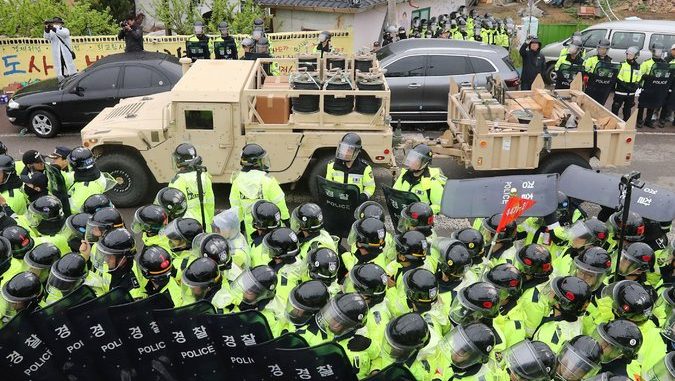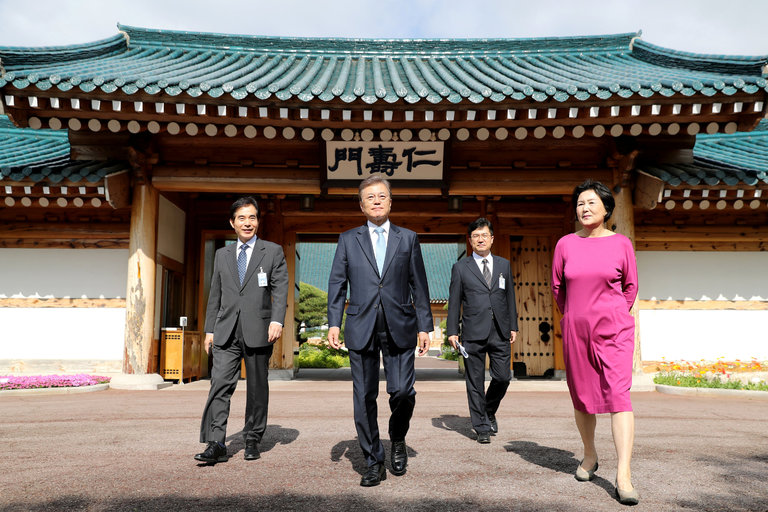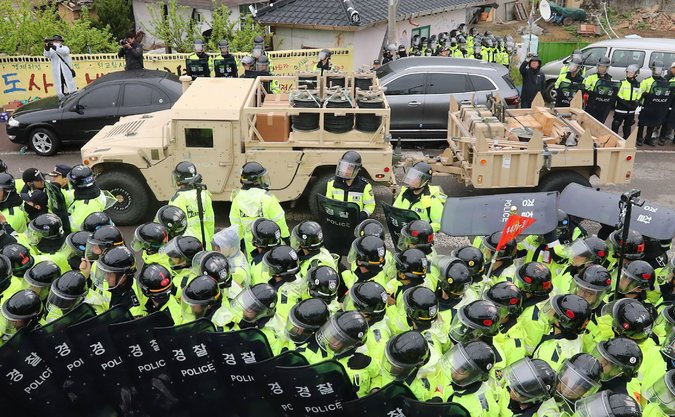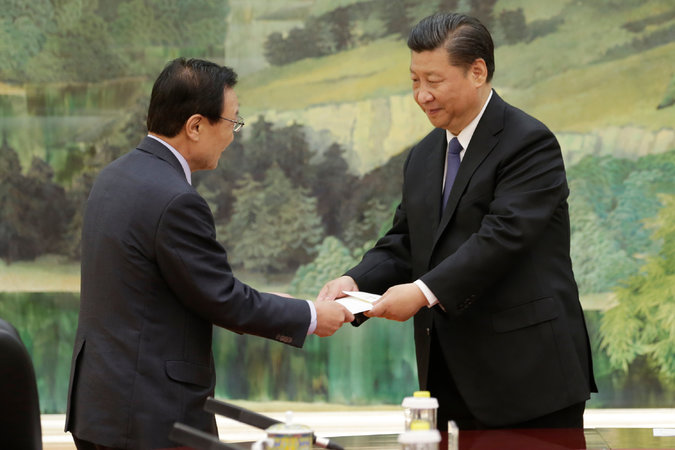
Designed to protect South against North, THAAD, China says, undermines its ability to deter nuclear attack & is key to anti-Beijing encirclement by US / Japan / South Korea strategic regional architecture. “Stopping the deployment of THAAD is the bottom line of China,” Global Times, state-run newspaper that often reflects thinking of the Communist Party leadership, said soon after Moon’s election. “Seoul needs to make a choice between deploying THAAD and resuming Sino-South Korean relations. It should not hope to have it both ways.” How is Moon, a lawyer, going to finesse China’s demands that THAAD disappear — and the insistence of the US it remain? It will be difficult, and Trump’s distaste for alliances will make it even more so. In April, Trump called a five-year-old trade accord with South Korea “a horrible deal” that had left the US “destroyed.” During his campaign, Trump accused South Korea of not paying its share to maintain 28,500 American troops in the country, though once he took office, he called the alliance “ironclad.” Top: Part of the THAAD American missile defense system arriving in Seongju in April. Below: President Moon Jae-in of South Korea, center, at Seoul’s presidential Blue House in May.
When he assumed power in 2013, President Xi Jinping of China tried to court one of America’s main Asian allies, South Korea.
It worked for a while. Then the relationship soured.
South Korea’s president at the time, Park Geun-hye, showed great respect for Xi,
appearing shoulder to shoulder with him at a military parade in Tiananmen Square, the only US ally to do so.
Then she turned on Xi when he declined to rein in North Korea as much as she had expected.
Now Xi is trying again, wooing South Korea’s new leader, Moon Jae-in,
and still hoping to chip away at the US alliance with South Korea and fortify China’s position in Northeast Asia.
Moon, a proponent of engagement with North Korea, is a more natural friend for Xi than the conservative Ms. Park, who is in jail facing corruption charges.
As North Korea steps up the frequency of its missile tests and prepares for a sixth nuclear test,
it has become more important for China to make common cause with South Korea
if it wants to find a diplomatic solution to the standoff with the North, as Beijing insists that it does.
China’s relationship with North Korea, its ostensible ally, is at a ragged low — and its ties with the South are in poor shape.
All at once, Beijing is at odds with both Koreas.
But while Xi welcomes Moon as a preferable alternative to Ms. Park, he is concerned about one point of contention:
Xi has made it clear that an American missile defense system authorized by Ms. Park —
and quickly set up by the United States in South Korea just before Moon took office —
is a major obstacle to good relations.
Beijing complains that the system, the Terminal High Altitude Area Defense battery, known as THAAD,
which the Americans designed to protect South Korea against the North,
undermines China’s missile force and its ability to deter a nuclear attack.
China views THAAD as just one element in an effort to contain its military
by building a strategic architecture that would eventually connect South Korea, Japan and the United States.
“Stopping the deployment of THAAD is the bottom line of China,”
Global Times, a state-run newspaper that often reflects the thinking of the Communist Party leadership, said soon after Moon’s election.
“Seoul needs to make a choice between deploying THAAD and resuming Sino-South Korean relations.
It should not hope to have it both ways.”
How is Moon, a lawyer, going to finesse the demands of China that THAAD disappear — and the insistence of the United States it remain?
It will be difficult, Chinese experts say.
Xi will try to persuade Moon to make some unpalatable compromises, they say,
ones that would not sit well with the American military.
Already, Moon appears to be at loggerheads with the Pentagon.
On Tuesday, he ordered a wide-ranging investigation into how four new THAAD launchers had arrived in South Korea without his knowledge.
The launchers are intended to supplement the two Thaad installations already in place.
But even rejecting the new equipment may not satisfy China.
“South Korea could make a promise to only allow one set of THAAD on its territory,”
said Cheng Xiaohe, an associate professor of international relations at Renmin University in Beijing.
Cheng was referring to assessments that South Korea does not have sufficient THAAD batteries yet to protect the entire country, and will need more.
“But that’s not enough,” Cheng added.
“China could ask South Korea not to join a trilateral alliance with Japan and the United States.”
Since the 1990s, China has been concerned that the US wants to form a NATO-like alliance on its doorstep.
But given that Trump is rapidly dismantling the original NATO, I don’t think the Chinese should be all that worried.
Part of the American missile defense system arriving in Seongju in April. During the South Korean election campaign, Moon said he opposed the rushed deployment of the system, known as THAAD.
China could also demand that Moon’s government allow China to verify that
THAAD’s radar system can detect incoming missiles
only within 800 kilometers (about 500 miles) and not 2,000 kilometers (about 1,200 miles), Cheng said.
But China’s intrusive inspection of THAAD in South Korean territory for verification purposes would be rejected by the Pentagon, he acknowledged.
A Chinese rocket scientist, Wu Riqiang, said in an interview that
the THAAD system allowed the US to monitor Chinese intercontinental ballistic missiles from the moment they were fired from bases in central China.
The American military would then have the ability to differentiate between real warheads and decoys carried on the missiles, thus weakening China’s deterrent.
“I don’t think China can persuade South Korea to give up THAAD,”
said Wu, an arms control expert who has worked at China’s Defense Ministry.
In response to the missile defense system next door, he added,
“China will build more nuclear weapons but won’t do so publicly.”
During the South Korean election campaign, Moon opposed the rushed deployment of THAAD, noting that it had not been put to a vote.
Moon has asked South Korean lawmakers to assess the initial decision on deployment, a move intended to buy some time.
“There is a search for a face-saving trigger,”
said John Delury, associate professor of Chinese studies at Yonsei University in Seoul, South Korea.
“During the review, the THAAD equipment would stay there but would be turned off.”
Despite the difficulties over THAAD, China seems to sense that it has a better chance of driving a wedge between South Korea and the US
with Moon than with his predecessor, especially with Trump in the White House.
A South Korean envoy, Lee Hae-chan, meeting with President Xi Jinping of China in Beijing in May. Lee was on a mission to mend the rift between the countries that began under President Park Geun-hye.
Since the Korean War, when the United States fought to prevent the North from overrunning the South,
American presidents have kept their commitments to the alliance.
Xi can capitalize on Trump’s distaste for alliances.
In April, Trump called a five-year-old trade accord with South Korea “a horrible deal” that had left the US “destroyed.”
During his campaign, Trump accused South Korea of not paying its share to maintain 28,500 American troops in the country,
although once he took office he called the alliance “ironclad.”
Trump’s grumbling probably strikes South Koreans as more true to form.
Trump sent shudders through South Korean election campaign in April when he said he wanted Seoul to pay the estimated $1 billion cost of THAAD.
The opening moves between Xi and Moon have taken place indirectly and under subdued circumstances.
They have yet to meet.
A South Korean envoy, Lee Hae-chan, arrived in Beijing shortly after Moon assumed office.
Xi took matters into his own hands, showing who was in charge.
At a session between the Chinese and South Korean delegations in Beijing,
Xi sat alone at a head table with the other officials seated below him,
a choreography meant to show China’s dominance that was widely noted.
After the deployment of THAAD, Beijing, which is Seoul’s largest trading partner, encouraged Chinese consumers
to boycott South Korean cars, phones, bands, television shows and even kimchi.
Source: China Woos South Korea’s New Leader, but the U.S. Left Behind a Spoiler – The New York Times


